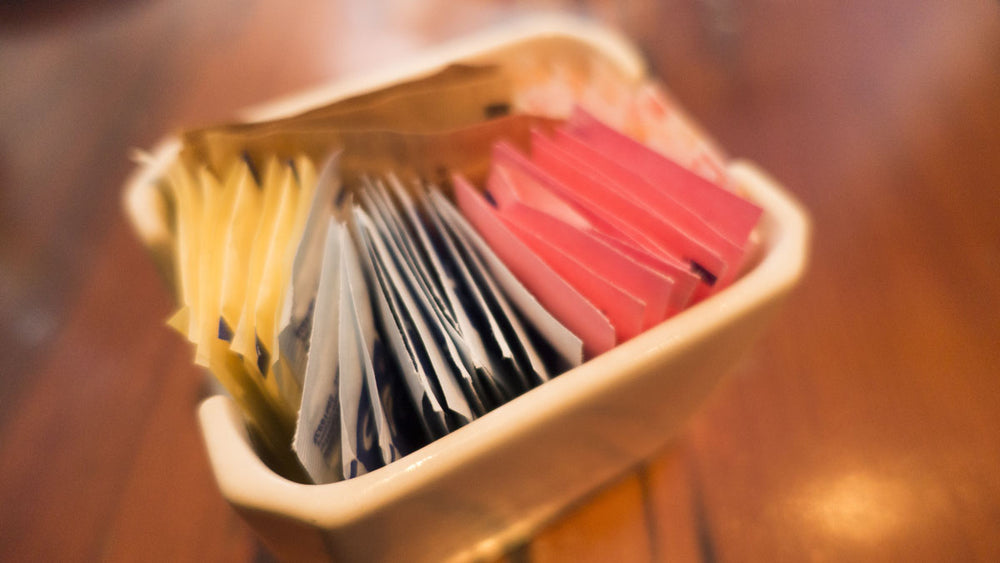Artificial sweeteners, AKA “non-nutritive” sweeteners have become an increasingly popular ingredient in processed foods in western culture.
Good chances are you ingest some form of artificial sweeteners daily if you eat processed foods.
Artificial sweeteners were originally introduced in North America back in the 1950s but the first (saccharin) was discovered in the 1800s. In the United States, the estimated consumption of artificial sweeteners in children/adolescents has increased by 200% and 54% in adults between the years 1999 and 2000 (MIND BLOWN).
Over the years, research has suggested that increased use of artificial sweeteners has led to a positive relation to the increase in inflammatory bowel diseases. There have been several studies that have demonstrated this increase with the introduction of saccharin and sucralose in the food supply in developed countries.
The Food and Drug Administration (FDA) has approved the use of 8 artificial sweeteners in the United States. They control how much can be used, where, and how it can be used. However, you may wonder- not everyone consumes the same amounts of every food so how can we truly know it's safe?
Acceptable Daily Intake (ADI) as defined by the FDA, is the amount of a substance that is considered safe to consume each day throughout a person's lifetime. After a food additive like an artificial sweetener is approved for use, federal officials in the FDA monitor the extent of the population’s consumption and review ongoing research to determine if current use is deemed safe.
(Synthetically derived)
- Aspartame
- Acesulfame potassium (Ace-K)
- Neotame
- Saccharin
- Sucralose
- Advantame
(Naturally derived from plants)
- Stevia
- Monk fruit extract
Animal and cell studies have identified that artificial sweeteners use could possibly pose harm to humans. However, data may be difficult to relate to humans because animals metabolize some nutrients differently and the amounts that affect them may be different from those in humans.
Below is a summary of some of the findings from a recent review looking into artificial sweeteners and their effects:
- Bacterial diversity shift- a possible change in bacterial composition leading to dysbiosis
- Changes in bacterial metabolites such as short-chain fatty acids can encourage inflammatory responses in the gut
- Reduction in gut integrity by increasing biofilm formation leading to leaky gut
- Possible alterations in bile acid metabolism leading to maldigestion/malabsorption of nutrients
In a recent human study, daily oral consumption of beverages sweetened with sucralose or aspartame (amounts according to the FDA’s ADI) did not significantly affect the gut microbiome in healthy subjects over a 14-day exposure. Furthermore, there was no noted change in the profile of the microbiome, and the metabolism of short-chain fatty acids was also unaffected by the consumption of these artificial sweeteners.
For IBS sufferers who follow a Low FODMAP diet, artificial sweeteners such as the ones listed above are mostly considered Low FODMAP and considered safe per the FDA. However, if you are experiencing unpleasant gastrointestinal side effects talk with a Registered Dietitian to figure out ways to manage your symptoms through diet. Nutrition professionals are staying up-to-date on current research regarding food additives (including artificial sweeteners).
- Ahmad, S. Y., Friel, J., & Mackay, D. (2020). The effects of non-nutritive artificial sweeteners, aspartame, and sucralose, on the gut microbiome in healthy adults: Secondary outcomes of a randomized double-blinded crossover clinical trial. Nutrients, 12(11), 3408.
- Rodriguez-Palacios, A., Harding, A., Menghini, P., Himmelman, C., Retuerto, M., Nickerson, K. P., Lam, M., Croniger, C. M., McLean, M. H., Durum, S. K., Pizarro, T. T., Ghannoum, M. A., Ilic, S., McDonald, C., & Cominelli, F. (2018). The Artificial Sweetener Splenda Promotes Gut Proteobacteria, Dysbiosis, and Myeloperoxidase Reactivity in Crohn's Disease-Like Ileitis. Inflammatory bowel diseases, 24(5), 1005–1020.
- Basson, A. R., Rodriguez-Palacios, A., & Cominelli, F. (2021). Artificial sweeteners: History and new concepts on inflammation. Frontiers in Nutrition, 8.
- Center for Food Safety and Applied Nutrition. (n.d.). High-intensity sweeteners. U.S. Food and Drug Administration. Retrieved October 28, 2022.
- Sylvetsky, A. C., Jin, Y., Clark, E. J., Welsh, J. A., Rother, K. I., & Talegawkar, S. A. (2017). Consumption of low-calorie sweeteners among children and adults in the United States. Journal of the Academy of Nutrition and Dietetics, 117(3).
- Suez, J., Korem, T., Zilberman-Schapira, G., Segal, E., & Elinav, E. (2015). Non-caloric artificial sweeteners and the microbiome: findings and challenges. Gut microbes, 6(2), 149–155.
- Ruiz-Ojeda, F. J., Plaza-Díaz, J., Sáez-Lara, M. J., & Gil, A. (2019). Effects of Sweeteners on the Gut Microbiota: A Review of Experimental Studies and Clinical Trials. Advances in nutrition (Bethesda, Md.), 10(suppl_1), S31–S48.



















Comments
Join The Conversation...